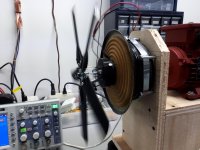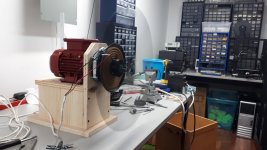There is a Crown DC-300 for sale at Maxwell's house of music in Jeffersonville IN. At least it was in a Louisville.Craigslist.org ad 12/13/19 with multiple devices shown, usually his ad although he doesn't list his name. Warning, these contain an obsolete op amp that if damaged is irreplacable.
Used for controlling DC actuators on diesel motor throttles and like applications. In '74-'77 I worked for a company that did exploration for oil with bladders driven by 3000 hp of hydraulic pumps. Two V-12 Catepillar diesels in parallel. The bladder swept 1/2 to 20 hz to produce an acoustic signature from the earth under the sea. The hydraulic flow was controlled by a vickers solenoid valve driven by a sweep generator. Daft procedure no longer used I believe. You might have enjoyed being present. What I heard was not infrasound but the rattling of the tin sheds on the deck.
Used for controlling DC actuators on diesel motor throttles and like applications. In '74-'77 I worked for a company that did exploration for oil with bladders driven by 3000 hp of hydraulic pumps. Two V-12 Catepillar diesels in parallel. The bladder swept 1/2 to 20 hz to produce an acoustic signature from the earth under the sea. The hydraulic flow was controlled by a vickers solenoid valve driven by a sweep generator. Daft procedure no longer used I believe. You might have enjoyed being present. What I heard was not infrasound but the rattling of the tin sheds on the deck.
Last edited:
Is there something wrong with the suggestion of Crown XLS series amplifiers in post #9?
Quoted Frequency Response is (1W, 20Hz - 20kHz)
Please clear my doubts, I´m straight answering your original question but need more details.
As I see it, unlike any type of "piston" speaker, your modulated fan CAN go down to DC.
In fact, all fans produce Acoustic DC, just unmodulated.
In yours, blades rotate at constant speed and output is produced by varying blade pitch ... please confirm/deny.
Yes that is correct ... like a helicopter controls blade pitch
IF so, a DC supply drives the electric motor, and Audio power drives the blade actuators. Yes/No
Yes ... the motor is a 220 volts 3 phase design that is controled buy a VFD (Variable Frequency Drive) and runs at 800 RPM
IF so, please provide the actuator schematic, with coil data: drive voltage needed, and resistance/impedance.
Speaker motor came from a 15" subwoofer with a 2" voice coil and a spider diameter of 7". Impedance is 8 ohms and can support 150 watts RMS
If none of this applies and you actually want to drive a bidirectional rotary motor with Audio, then I´m out of this, sorry.
Good luck with your project
As I see it, unlike any type of "piston" speaker, your modulated fan CAN go down to DC.
In fact, all fans produce Acoustic DC, just unmodulated.
In yours, blades rotate at constant speed and output is produced by varying blade pitch ... please confirm/deny.
Yes that is correct ... like a helicopter controls blade pitch
IF so, a DC supply drives the electric motor, and Audio power drives the blade actuators. Yes/No
Yes ... the motor is a 220 volts 3 phase design that is controled buy a VFD (Variable Frequency Drive) and runs at 800 RPM
IF so, please provide the actuator schematic, with coil data: drive voltage needed, and resistance/impedance.
Speaker motor came from a 15" subwoofer with a 2" voice coil and a spider diameter of 7". Impedance is 8 ohms and can support 150 watts RMS
If none of this applies and you actually want to drive a bidirectional rotary motor with Audio, then I´m out of this, sorry.
Good luck with your project
Lets do a quick hatchet job on the Blameless Class B... and this will show how to approach altering any suitable design
We remove the input coupling cap and short out the feedback return cap. This amp is actually pretty good and gives a DC offset in this state of under 2 volts DC.
The imbalance at this point is caused by the 10k input resistance R1 and the 500 ohm feedback return R6.
So we make R1 approximately 500 ohm. The offset is now less than 100mv.
You now have a small problem of actually driving the DC coupled amp because the input impedance has to remain at that 500 ohm level. One option is to add an opamp in front with a 500 ohm series resistor (you can tweak the value to get zero volt DC offset at the final amp output. This now allows for us to set the overall input impedance to whatever we wish (100k here).
Cautions...
A relay delay at the output would be mandatory because switch on and probably switch off will not be pretty in terms of transients generated.
The opamp should probably be a FET type like an OPA134 etc.
Higher power can be achieved by using two or possibly three pairs of output transistors.
All this would be a starting point for converting an amp to DC operation.
Fascinating ... thanks
View attachment 802185
Here is a DC-capable but DC-stable circlotron amp. It will need more paralleled P-channel MOSFETS on the output to lower distortion and lower output impedance. I have not optimized this amp yet, so distortion is way to high. See it as fast and rough early draft.
I would prefer some IXYS devices (IXTN120P20T) on the output instead of IR/Infineon devices, but I don´t know how to add those to LTSpice.
I appreciate your efforts
Scott
Very cool!There is a Crown DC-300 for sale at Maxwell's house of music in Jeffersonville IN. At least it was in a Louisville.Craigslist.org ad 12/13/19 with multiple devices shown, usually his ad although he doesn't list his name. Warning, these contain an obsolete op amp that if damaged is irreplacable.
Used for controlling DC actuators on diesel motor throttles and like applications. In '74-'77 I worked for a company that did exploration for oil with bladders driven by 3000 hp of hydraulic pumps. Two V-12 Catepillar diesels in parallel. The bladder swept 1/2 to 20 hz to produce an acoustic signature from the earth under the sea. The hydraulic flow was controlled by a vickers solenoid valve driven by a sweep generator. Daft procedure no longer used I believe. You might have enjoyed being present. What I heard was not infrasound but the rattling of the tin sheds on the deck.
If its a commercial unit please post the datasheet. If you are home-brewing one
that's going to be an interesting project.
Eminent Technology TRW-17 Rotary Subwoofer | Sound & Vision
I like the op-amp input buffer and a FET diff-amp with ~zero bias current avoids the issue with different bias resistors but matching FETs may be an issue. In any case, an offset trim pot seems the obvious solution. An offset trim can be added to any amplifier.
I don't know if anybody said this. Ideally any ultra low frequency device needs time alignment. Not impossible to do. When a pipe organ the organist is this device. When correct the sound is deeper and sweeter. I doubt this application has this requirement.
It's said people who live near wind farms feel unsettled. Even though not vary audible they feel something. My dad for years thought something like a big truck was running nearby. He walked for miles at night trying to find it. I heard it but couldn't get excited. I later found that we lived near a high pressure gas pipeline. These are known for this problem. From what I know what we might hear is a harmonic. Funny thing with dad was in the end he forgot about it.
It's said people who live near wind farms feel unsettled. Even though not vary audible they feel something. My dad for years thought something like a big truck was running nearby. He walked for miles at night trying to find it. I heard it but couldn't get excited. I later found that we lived near a high pressure gas pipeline. These are known for this problem. From what I know what we might hear is a harmonic. Funny thing with dad was in the end he forgot about it.
- Home
- Amplifiers
- Solid State
- Looking for an Infrasonic amplifier

